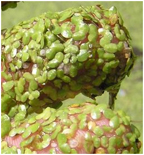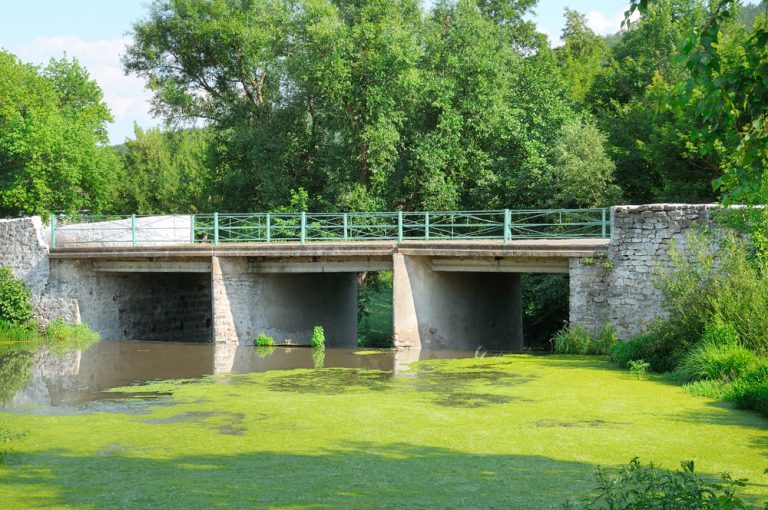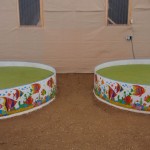Duckweed to Feed Tilapia in Aquaponics – The Food of the Future
– by Colle and Phyllis Davis
 Duckweed MAY be the food of the future. Grown under ideal conditions, duckweed ranges between 25% and 45% protein and doubles its growth every 36 hours, and OUR TILAPIA love to eat it along with their fish chow.
Duckweed MAY be the food of the future. Grown under ideal conditions, duckweed ranges between 25% and 45% protein and doubles its growth every 36 hours, and OUR TILAPIA love to eat it along with their fish chow.
We do not profess to be experts at growing farm-raised duckweed to feed our fish. In fact, quite the opposite is true. We have grown duckweed in kiddy-pools, large and small containers and even open-air tanks off-and-on for many years and we have not always been successful in our efforts to maintain our duckweed farms, but we keep trying and we continue to experiment to find the answers to pass along to you.
 Duckweed seems to overgrow in places that people do not want it to grow – like ponds, rivers and lakes, but it’s been difficult for us to raise it in tubs for more than a few weeks before it dies. If duckweed covers the surface of a body of water, there is an oxygen depletion which kills fish in the ponds, rivers or lakes. (Feed tilapia only enough for them to eat. The remnants are picked off over time.)
Duckweed seems to overgrow in places that people do not want it to grow – like ponds, rivers and lakes, but it’s been difficult for us to raise it in tubs for more than a few weeks before it dies. If duckweed covers the surface of a body of water, there is an oxygen depletion which kills fish in the ponds, rivers or lakes. (Feed tilapia only enough for them to eat. The remnants are picked off over time.)
Our latest experiments for growing duckweed suggests putting PVC pipes or PVC fittings in the water in the tanks for the duckweed to grow around it (which makes sense) so we’re going to try that and we’ll keep you posted.
If you plan to raise enough farm-raised duckweed to feed your fish for a commercial sized-farm, we recommend you speak with a local botanist in your area that might be able to guide you better than we can. There is a vast amount of scientific research and available information on the Internet about duckweed.

Image of duckweed growing near a bridge. If you look for areas near your own home with standing water, you may see your own ‘starter batch’ of duckweed.
Fun fact: People asked us for a long time what duckweed tasted like. One day our construction engineer said, “Well, I guess you ought to taste it so you can tell them.” So I did. It tastes like watercress. Tangy, peppery and very clean tasting. “Thought you’d like to know.” – Colle
Also, starch that comes from duckweed can quickly be changed into ethanol, which it can used instead of corn for ethanol. Farmers from large-scale hog farms, rid their waste through large duckweed lagoons.” It helps manage their animal wastes through biological treatment and can even ‘clean’ hog-waste water and makes the water potable by running the water through enough duckweed. Interesting, eh?
Here are a few links for you to study duckweed and its benefits and complexities:
http://www.fishfarming.com/duckweed.html
http://www.lrrd.org/lrrd7/1/3.htm
http://en.wikipedia.org/wiki/Lemna
http://www.mobot.org/jwcross/duckweed/Fish.htm
 Duckweed in kids 8′ kiddy pools
Duckweed in kids 8′ kiddy pools
In fact, here is a link to a technical working paper by researchers for the World Bank, Duckweed Aquaculture, A New Aquatic Farming System for Developing Countries, by Paul Skillicorn, William Spira and William Journey – Emena Technical Department, Agricultural Division.
Advice for ridding unwanted duckweed from ponds from the Royal Horticultural Society in London:
Non-chemical controls: Complete control is impossible and growth should be controlled before it reaches nuisance levels. Try the following for control and prevention of duckweed:
- On small ponds repeated raking or netting will keep the weed under control. Continuous removal is usually necessary
- On larger pools use a floating boom to sweep from end to end. Sweep at intervals from early in the season and continue until winter dormancy
- You can compost the removed weed
- Fit stop-boards at any upstream inlets to prevent duckweeds entering ponds or lakes
- Weed-eating water birds, such as domestic and ornamental ducks, moorhens and coots will provide some degree of control
- Grass carp will eat Lemna species
- Shading can reduce duckweed growth. This can be achieved by planting on the south side of the pond. Waterlilies and other plants with floating leaves can also substantially reduce the level of duckweed. The use of a fountain to disturb the surface may also help

14 pings
Skip to comment form